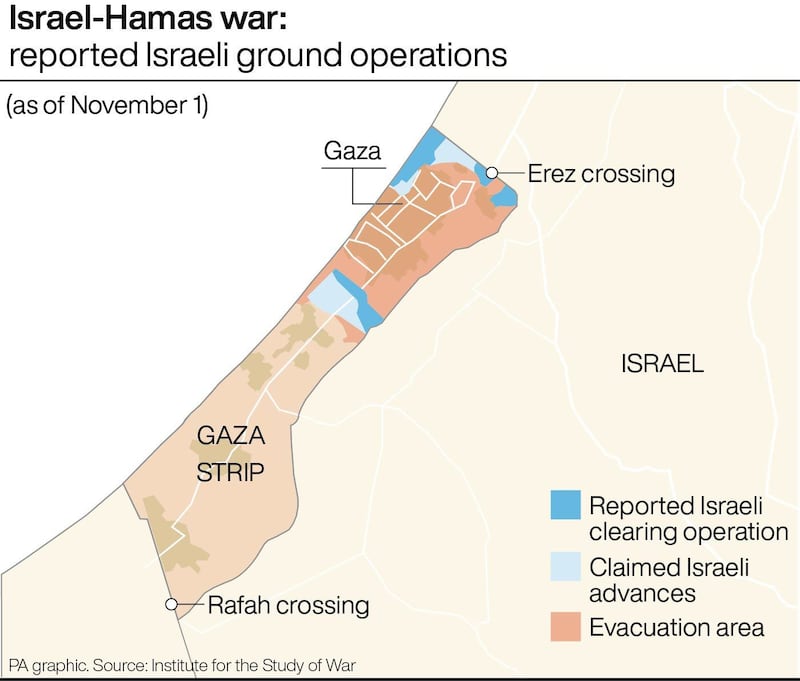Israel’s military said it had surrounded Gaza City as its ground offensive against Hamas in the besieged enclave moved into a new phase despite mounting international pressure for a pause in the fighting.
“Our soldiers completed the encirclement of Gaza City, the focus of the terrorist organisation Hamas,” said Rear Admiral Daniel Hagari, spokesman for the Israel Defense Forces.
“In the last few hours, armoured troops, infantry and (air force) attacked the placements, launch positions, headquarters and additional terror infrastructures that serve the leadership of Hamas and its terrorists.”
Herzi Halevi, Israel’s top military commander, said that its ground offensive had moved into a new stage with its operation to encircle Gaza City, which was home to 500,000 people before the war began.
Gaza: Israeli strikes kill ‘at least 39 Palestinians’ and destroy medical supplies
Life in a Lebanese Palestinian camp: ‘We still don’t feel safe. At any time they may strike here as well’
United States steps up efforts to secure a ceasefire in Lebanon
‘Stop this horror of history,’ says President Higgins as Israel moves to ban aid agency
Satellite images and reports on social media earlier showed Israeli forces advancing in three directions: Israeli tanks were massed near the coast in the north of Gaza, with reinforcements crossing from Israel into the strip from the north-east, while additional armoured columns headed towards the sea south of Gaza City.
[ Edward Luce: Netanyahu is an albatross around Biden’s neckOpens in new window ]
Israel has intensified its air and ground operations against targets in Gaza despite calls from allies, including US president Joe Biden on Wednesday, for a “pause” in hostilities to help free hostages held captive by Hamas.
US secretary of state Antony Blinken is expected to relay the message to Israeli leaders on Friday, on the first leg of his latest diplomatic tour of the Middle East.
Israel has hit Gaza City alone with 10,000 munitions since Hamas’s rampage through southern Israel on October 7th, defence minister Yoav Gallant said on Wednesday.
[ Europe Letter: European credibility in the Middle East is in ashesOpens in new window ]

Fintan O'Toole on Israel, Gaza and the equality of human life
The response to the Hamas terror attack on October 7th has been fierce. In the weeks since then, Israel has unleashed a war against Hamas but in which thousands of civilians in Gaza have lost their lives. Where will that war lead, and who will rule Gaza if Israel achieves its goal of eliminating Hamas? Irish Times columnist Fintan O'Toole talks to Hugh Linehan about why the only viable process is a peace process - and why Israel's current government is not able to envisage one.
Palestinian health officials said that almost 200 people were killed in air strikes on the Jabalia refugee camp in the north of Gaza on Tuesday and Wednesday. The Israeli military said it had targeted a high-ranking commander in a strike on Wednesday evening, but denied hitting a school in the area.
Israel’s bombardment has killed at least 9,025 people in Gaza, according to Palestinian officials. Hamas’s attack on Israel killed 1,400 people, according to Israeli officials, with 242 hostages taken back to Gaza. Israeli officials said 18 Israeli soldiers had been killed since its forces began their ground offensive in Gaza.
Tensions also remain high at Israel’s border with Lebanon. Lebanon-based Hizbollah militants said they had launched two drones laden with explosives into a sliver of disputed territory called Shebaa Farms, at present occupied by Israel. It was the first time the Iran-backed group claimed to have used explosive drones against Israel.
Meanwhile, Hamas fighters in Lebanon fired rockets into Israeli communities near the border, hitting a building in the city of Kiryat Shmona. Israel responded with a cross-border air strike.

Mr Biden’s call for a pause in fighting between Israel and Hamas did not represent a call for a full ceasefire, which the White House has resisted. But US officials have said in recent days that they would consider supporting a temporary halt in hostilities if it were limited to helping humanitarian efforts.
About 300 aid trucks have been allowed into Gaza since the beginning of the war, compared with more than 400 a day before the war began. Mr Biden has repeatedly asked the Israelis to facilitate more aid, saying on Wednesday that the relief efforts “had a long way to go”.
Israel’s government has said that the humanitarian situation in Gaza remains manageable, although the UN and others report widespread shortages of food, clean water and medicine.
“The levels of distress and the unsanitary living conditions were beyond comprehension,” said Philippe Lazzarini, commissioner-general of UNRWA, the main relief agency for Palestinian refugees, after visiting Gaza on Wednesday. “Everyone was just asking for water and food.”

Mr Biden said he understood the “emotion” that the conflict was eliciting on all sides. “This is incredibly complicated for the Israelis. It’s incredibly complicated for the Muslim world as well,” he said. “I supported a two-state solution. I have from the very beginning.”
More foreign nationals and some wounded Palestinians were waiting to be allowed out of the Rafah crossing on Gaza’s border with Egypt, western diplomats said. Just under 400 were allowed out on Wednesday, while 61 aid trucks were permitted to enter.
Hamas’s proposed exit list on Thursday had the names of about 600 foreign nationals on it, including about 400 US citizens. Some 74 Americans were able to leave, Mr Biden said. - Financial Times Service



